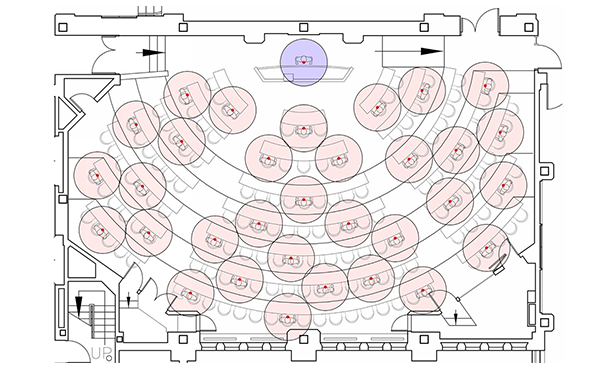1. Know Your Enemy
Understanding how COVID-19 is transmitted and how to reduce the rate of infection is the first step to establish a physical space re-occupancy plan. Our recent work and research has led us to use these guiding principles:
- The virus is thought to spread mainly from person-to-person. This is why physical distancing and mask wearing is so important!
- Though not thought to be the main way the virus spreads, it can spread from surface to person by a person touching a contaminated surface, then touching their mouth, nose, or eyes. This is one of the reasons why hand washing and cleaning surfaces, particularly those that are frequently touched like door handles, are important factors in reducing spread.
- Many organizations, such as the Harvard T.H. Chan School of Public Health, have acknowledged the likelihood of airborne transmission in interior spaces.
Infection is a factor of exposure and time. For example, speaking releases 200 particles/minute (sneezing can be 200 million!). You will be exposed to more particles the more time you spend around an infected person. An infectious dose of COVID-19 is thought to be in the high hundreds or low thousands of particles. - Being outside is best. The odds of transmission in a closed environment are 18.7 times greater compared to an open-air environment!
2. Assess Rooms Individually
Using a generalized square foot per person or percentage reduction in capacity DOES NOT WORK. We have experienced this ourselves by developing physically distant plan diagrams for a university and restaurant. We have heard the same feedback from colleague after colleague. We cannot recommend enough that each space be assessed individually. Things such as fixed seating, accessibility, room proportions, ventilation, circulation through the space, etc. can drastically impact safe capacity. Also, consider how people will enter and exit the room and get to their seat or workspace while maintaining distancing.
3. Engage Outdoor Space
As noted in tip #1, the odds of transmission outdoors are 18.7 times lower than indoors. Many of our clients are activating underutilized outdoor space to help them achieve greater capacity and safety. While our New England climate will be tough to bear in the winter, we can enjoy the lovely days of late summer and fall outside. Consider outdoor heaters to extend the useful season.
4. Limit Time in Corridor
Code-required ventilation levels are lower in corridors than in other spaces such as classrooms or workspaces. Identify and clearly communicate where people can go between classes or meetings. Also consider increasing ventilation (in all spaces, not just corridors) by opening windows and/or modifying mechanical equipment.
5. Create Physically Distant Social Spaces
We say physical distancing instead of social distancing. Have you noticed? This is on purpose. We make this distinction because maintaining social connections is so important for our health and wellbeing. We recommend NOT closing off existing social spaces, but instead modifying them to encourage physically distant socializing. For example, sofas can be swapped for chairs or seat-blocking straps can be added. Also, spaces that previously served a different purpose may be well-suited to becoming a safe social space for previously unconsidered uses.
6. Beware of Antimicrobials
Every time we see an ad for a fabric or other material with antimicrobials we cringe. It sure sounds good, but they HAVE NOT been shown to be effective and HAVE been shown to be hazardous to health. Evidence suggests antimicrobials like Triclosan can contribute to antibiotic resistance, may increase allergen sensitivity and symptoms, and exacerbate asthma. There are also studies in animals that show it may be an endocrine-disrupting chemical that could interfere with estrogen-dependent responses and testosterone concentrations, potentially adversely affecting sperm quality and birth outcomes. Additionally, antimicrobials may be contributing to the spread of resistant bacteria – a scary thought, especially now! Antimicrobials can be absorbed through the skin, but the virus cannot. We recommend good cleaning practices and NOT using materials with antimicrobials.
Need some more help? We’re here for you. Check out our Transitioning Services.
Photo credit: James Sutton on Unsplash






